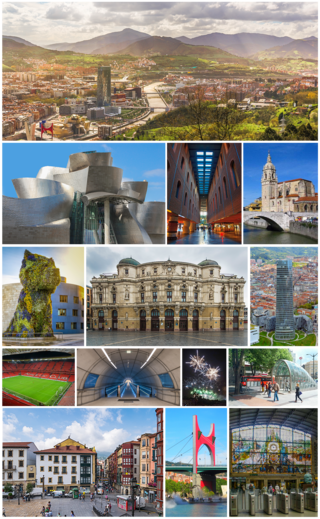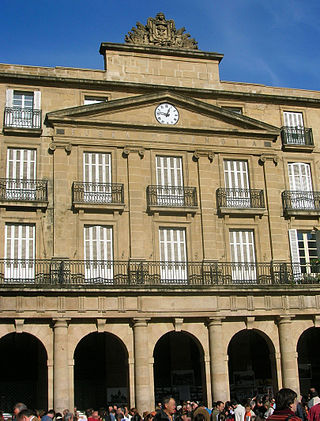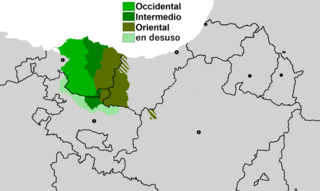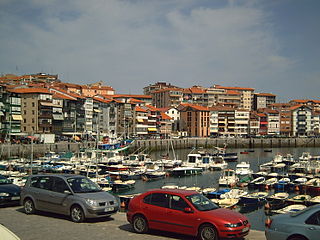
Bilbao is a city in northern Spain, the largest city in the province of Biscay and in the Basque Country as a whole. It is also the largest city proper in northern Spain. Bilbao is the tenth largest city in Spain, with a population of more than 347,000 as of 2023. The Bilbao metropolitan area has 1,037,847 inhabitants, making it the most populous metropolitan area in northern Spain; with a population of 875,552, the comarca of Greater Bilbao is the fifth-largest urban area in Spain. Bilbao is also the main urban area in what is defined as the Greater Basque region.

Saint-Jean-de-Luz is a commune in the Pyrénées-Atlantiques department, southwestern France. Saint-Jean-de-Luz is part of the Basque province of Labourd (Lapurdi).

Euskaltzaindia is the official academic language regulatory institution which watches over the Basque language. It conducts research, seeks to protect the language, and establishes standards of use. It is known in Spanish as La Real Academia de la Lengua Vasca and in French as Académie de la Langue Basque.
The Basque alphabet is a Latin alphabet used to write the Basque language. It consists of 27 letters.

Erandio is a town and municipality located in the province of Biscay, in the autonomous community of Basque Country, northern Spain.

Galdames is a town, valley, and municipality located in the Biscay province of the autonomous community of Basque Country, Spain.

Getxo is a town located in the province of Biscay, in the autonomous community of the Basque Country, in Spain. It is part of Greater Bilbao, and has 77,946 inhabitants (2019). Getxo is mostly an affluent residential area, as well as being the third largest municipality of Biscay.

Sestao is a town and municipality of 27,296 inhabitants located in the province of Biscay, in the autonomous community of Basque Country, northern Spain. It is in the left bank of the Estuary of Bilbao and part of Bilbao's metropolitan area.

Biscayan, sometimes Bizkaian, is a dialect of the Basque language spoken mainly in Biscay, one of the provinces of the Basque Country of Spain.

Basque rural sports, known as Deportes Rurales in Spanish or Herri Kirolak in Basque, is the term used for a number of sports competitions rooted in the traditional lifestyles of the Basque people. The term force basque is used in French.

A trainera is a traditional boat of the Cantabrian sea coast at the southern end of the Bay of Biscay, propelled by oars, and formerly sailing. It is a boat of fine lines with raised prow and rounded stern, to resist the waves of the Cantabrian sea. Traineras were originally used by fishermen to bring in the day’s catch of anchovies and sardines from sea to market, usually competing to sell their caught fish before others came in. Today, this historical tradition has become a major sport of coastal boat racing.

Jesús Guridi Bidaola was a Spanish Basque composer who was a key player in 20th-century Spanish and Basque music. His style fits into the late Romantic idiom, directly inherited from Wagner, and with a strong influence from Basque culture. Among his best-known works are the zarzuela El Caserío, the opera Amaya, the orchestral work Ten Basque Melodies and his organ works, where the Triptych of the Good Shepherd can be highlighted.

Resurrección María de Azkue was an influential Basque priest, musician, poet, writer, sailor and academic. He made several major contributions to the study of the Basque language and was the first head of the Euskaltzaindia, the Academy of the Basque Language. In spite of some justifiable criticism of an imbalance towards unusual and archaic forms and a tendency to ignore the Romance influence on Basque, he is considered one of the greatest scholars of Basque to date.

Erromintxela is the distinctive language of a group of Romani living in the Basque Country, who also go by the name Erromintxela. It is sometimes called Basque Caló or Errumantxela in English; caló vasco, romaní vasco, or errominchela in Spanish; and euskado-rromani or euskado-romani in French. Although detailed accounts of the language date to the end of the 19th century, linguistic research began only in the 1990s.

The Day of the Geese, also known as Antzar Eguna, is a competition held as part of the San Antolín festival in the Basque fishing-town of Lekeitio, in which participants attempt to decapitate a goose suspended on a rope above the town harbor. Chicken are also often used.

Goose pulling was a blood sport practiced in parts of the Netherlands, Belgium, England, and North America from the 17th to the 19th centuries. It originated in the 12th century in Spain and was spread around Europe by the Spanish Third. The sport involved fastening a live goose with a well-greased head to a rope or pole that was stretched across a road. A man riding on horseback at a full gallop would attempt to grab the bird by the neck in order to pull the head off. Sometimes a live hare was substituted.

The laia is a two-pronged type of foot-plough used in the Basque Country. Aside from being a farming implement, it is also used in laia racing. The people using a laia are referred to as laiariak in Basque.
Tourism in the Basque Autonomous Community has increased considerably in recent years, and is a popular destination for tourists from Spain and France. According to data from the Eustat the number of tourists entering the region in the year 2009 was 1,991,790, with the final result still pending. 71% of the yearly visitors come from the rest of Spain; the greatest number from Madrid Autonomous Community (14.2%), and Catalonia (11.1%). International visitors make up the remaining 29% - the largest percent come from France (7.2%). 62% of the people who come to the Basque Autonomous Community visit one of the three capitals, 27% visit inland and 11% visit the coast. The average stay of the visitors is 2 days.

Julio de Urquijo e Ibarra, Count of Urquijo (1871-1950), in Basque self-styled as Julio Urkixokoa, was a Basque linguist, cultural activist, and a Spanish Carlist politician. As a Traditionalist deputy he twice served in the Cortes, during the terms of 1903-1905 and 1931-1933, though the climax of his political activity fell on the late Restoration period. As a scientist he was the moving spirit behind setting up numerous vascologist institutions, especially Revista Internacional de Estudios Vascos (1907) and Sociedad de Estudios Vascos (1918). Himself he specialized in Basque paremiology and bibliography. He opposed academy-driven unification of Basque dialects and preferred to wait until standard Basque emerges naturally.

Armintxe Cave in Lekeitio (Spain) is an important Paleolithic rock art site, estimated to date from between 12,000 and 14,500 years ago.
























